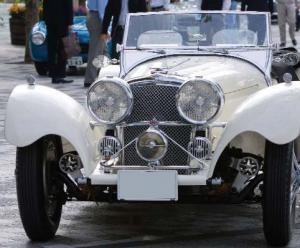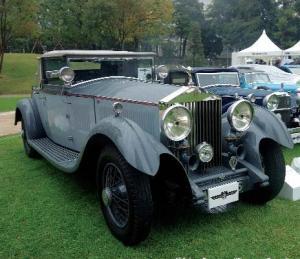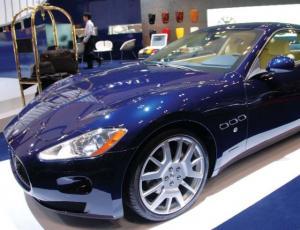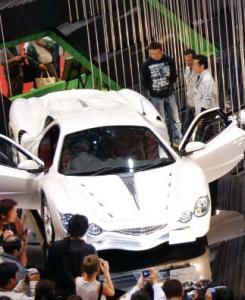Reflections on Wheels
By Timothy Coghlan
Inspired by two grand automotive events in Tokyo at the end of last year, Timothy Coghlan shares his thoughts on the automotive industry and the changes in consumer trends, brand strategy and the car market in Japan.
 The 1937 Jaguar SS100 - Classic Car Photography Copyright © Tokyo Concours d’Elegance Operations Office 2007 All Rights Reserved
The 1937 Jaguar SS100 - Classic Car Photography Copyright © Tokyo Concours d’Elegance Operations Office 2007 All Rights Reserved
How many of you remember the first car you owned, or the family car when you were a child? I’m sure most of us do. And how often do you see cars from those bygone eras on the streets of Tokyo? To the untrained eye, the answer is likely to be ‘almost never,’ as the Japanese preference (or obsession) with things clean, tidy and new ensures most old cars are retired or exported before they reach their teenage years.
There is no doubting that Japan has one of the most modern auto fleets in the world with people updating their car every few years (one prolific car maker operates on a five year customer upgrade cycle in Japan as opposed to seven years in other countries). Despite the obvious advantages of fewer breakdowns and traffic ‘eye sores’ that old autos plague us with, for many people this modern motoring fleet is rather dull—scores of 21st century, automatic, efficient and neutrally colored cars quietly snake their way around the country, leaving little room for the style, nostalgia and elegance of the cars of yesteryear.
However, if you pay attention, there is actually a significant contingent of old cars on Japan’s roads. The main difference from other countries is that these cars tend to be in pristine condition and a pleasure to behold as opposed to the ‘bombs’ and other run down cars that troll their way along the tarmac of many other countries.
Concours d’Elegance.
In a three-day event held late last October, a collection of some of Japan’s best privately owned vintage and classic cars came together for the inaugural Tokyo Concours d’Elegance—a classic car event that mimics similar events in Italy, France and the USA. The event kicked off with a befitting cruise through Tokyo’s ritzy Ginza, Omotesando and Aoyama districts before winding its way to Tokyo Midtown where the cars were put on display and faced a panel of esteemed judges for honors of best vintage, best pre and postwar classics and modern classics etc. The Best of Show prize was awarded to the 1930 Rolls-Royce Phantom II Continental DHC by Carlton. The public was also given the chance to vote for their favorites which resulted in the Jaguar SS100 winning three of the six awards including: Best of Show (Public), Best Class B Classic Car and the Ladies Choice Award.
 The 1930 Rolls-Royce Phantom II Continental DHC by Carlton
The 1930 Rolls-Royce Phantom II Continental DHC by Carlton
Organized by Paul Goldsmith—President of Esprit, a company that provides staff for the automobile and luxury brands sectors www.espritjapan.co.jp, Concours d’Elegance is aimed at getting classic cars out of their garages and bringing them together in one location. It provides a venue for owners to show off their pride and joy and a great opportunity for the public to marvel at the historic design and craftsmanship.
Vintage and classic cars are fascinating on a number of levels—from engineering and design history to their association with bygone eras and persons of fame and notoriety. They are also big business. According to Peter Spieth from the Mercedes-Benz Classic Center in Germany, the global classic car market is worth around €120 million (¥19.5 billion) per annum, which is made up of parts (spare), restoration and boutique items. This figure isn’t so difficult to believe considering that one car alone—a 1904 Rolls-Royce sold at auction for £3.5 million (¥800 million) in early December—setting a new record for vintage car prices.
With figures like these floating around, it’s surprising to learn that companies like Mercedes do not aim to make a profit through selling spare parts and assisting owners to restore their vintage and classic cars. Rather, they are in it for the culture and prestige. They believe that the magnificent cars will speak for themselves and add value to the company in other areas such as PR and marketing. Could there be a much better way to prove your brand’s quality, durability and capacity for innovation than having one of your products still running perfectly after 100 years?
 Maserati on display at the Tokyo Motor Show
Maserati on display at the Tokyo Motor Show
For auto makers, interest in their early models is not just an exercise in PR, but can also play a fundamental role in their design direction and company vision as the classic cars supplement the core values of each brand. “By taking a look at your roots it gives you a better idea of where you are going and helps you build a bridge to the future” remarks Spieth. Today the world’s biggest auto makers strive for continuity and smoothness of design changes, and therefore plan for ‘long term design.’ This was plainly discernable in the Concours d’Elegance displays as different brands aligned their early editions alongside their modern counterparts and future concept vehicles. This was especially visible in the front grill or ‘face’ of the cars from famous brands such as Bentley, Porsche, Mercedes-Benz and Audi whose grill designs have remained fairly consistent since the brands’ early conception.
One of the great things about the Tokyo Concours d’Elegance was the active involvement of the world’s top auto makers in the event. Companies such as Bugatti, Maybach, Rolls-Royce and Audi sent specially selected vehicles to Japan specifically to take place in the event, and Nissan exhibitioned its super-performance GT-R for the first time outside of the Tokyo Motor Show. And they did so side-by-side, each reveling in the uniqueness of the event, instead of each maker competing for space and brand individuality (as they do at the Tokyo Motor Show). The makers were willing to let their products speak for themselves in a united showcase of over a century’s worth of state of the art automotive design and craftsmanship.
The Tokyo Motor Show
Within Japan’s luxury car market you have the world’s top auto makers including: Jaguar, Porsche, Ferrari, Lamborghini, Rolls-Royce, Bentley, Bugatti, Aston Martin, Maserati, Maybach and Hummer (mostly European companies), all vying for a place on Tokyo’s status-stained streets. On my quiet street in a corner of Meguro alone there lives a Rolls-Royce, a Jaguar, several Porsches and Maseratis and more Mercedes than I can count. I once managed to catch a glimpse into one resident’s perpetually closed garage only to discover a collection of six different luxury cars.
All of these auto makers plus many more were on display at the 40th biannual Tokyo Motor Show also held at the end of October. In stark contrast to the set up around Midtown for Concours d’Elegance where the ‘ladies’ gaining attention were the cars and brand marketing was nowhere to be seen, at the Tokyo Motor Show flamboyance was the aim of the game as each company tried to outdo each other with cinema, 3D and even ice displays as well as the ever-present scantily clad ladies.
The position of different car companies on the luxury ladder was easily detected through the intricacy of each display at the Motor Show. Companies such as VW and Yamaha went to great lengths to produce creative and interactive stands that were entertaining, fun and provided glimpses into the future as well as letting you get up close to the car.  Lamborghini on the other hand, simply featured three cars and three ladies and kept spectators at bay behind a glass fence, yet managed to create a frenzy as attendees’ jockeyed their way for a position that would lend itself to getting a great picture of the car—or perhaps the girls.
Lamborghini on the other hand, simply featured three cars and three ladies and kept spectators at bay behind a glass fence, yet managed to create a frenzy as attendees’ jockeyed their way for a position that would lend itself to getting a great picture of the car—or perhaps the girls.
Course of action
Given the plethora of sporty, sleek, sexy and sumptuous automobiles out there, if you’re feeling a little tired of your current mode of transport, whether it be the train, a bicycle or if you’re well enough endowed, some kind of motorized vehicle, then why not make a change? Whether you decide on a new Bugatti Veyron for getting to the next red light as fast as possible (top speed 407km/h), a 1963 Aston Martin DB5 to feel like James Bond, or a 1910 Rolls-Royce Silver Ghost to go back in time, your only set backs are likely to be deciding on a color and delivery date, and perhaps your credit card limit.
JI
Timothy is a freelance writer based in Tokyo, he can be contacted at timkyo@gmail.com






